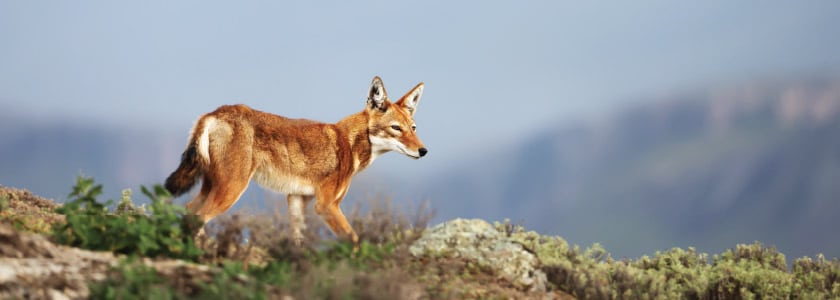Genomic studies are helping researchers learn more about the rarest carnivore in Africa—the Ethiopian wolf.
Only an estimated 500 Ethiopian wolves remain (and another estimate pins the number at more like 450). Canis simensis are found in a small cluster of high mountains (from around 10,000 feet elevation to 14,700 feet) in central Ethiopia, with two subspecies—a northern variant and a southern variant which are separated by the Great Rift Valley.
Roughly the size of a coyote, the Ethiopian wolf has a skinny, almost dainty appearance, with short hair and thick underfur to protect it from cold mountain temperatures. They are rusty red to ochre in color, with a distinct white band around the sides of the neck. The wolves live in groups of up to 20, rest together in the open at night, congregate for meetings or dawn patrols, eat rodents, and don’t harass livestock.
What is Threatening the Ethiopian Wolf Population?
Ethiopian wolf populations continue to shrink, and the species are beset by a number of threats. Habitat is disappearing as subsistence farming works higher into their territory, while rabies and distemper threatens the largest group, which includes some 250 adults and subadults in the Bale Mountains. Overgrazing, plowing, persecution, and negative human attitudes threaten other populations.
A mitochondrial DNA analysis in 1994 showed the Ethiopian wolves were more closely related to the gray wolf and coyote than other African canids and suggested the species may be an evolutionary relic of an ancient gray wolf which migrated from Eurasia. The preponderance of rodents, scholars hypothesized, resulted in the Ethiopian wolf developing an elongated head, long jaw, and widely spaced teeth.
A 2015 study of mitochondrial genome sequences and whole genome nuclear sequences, meanwhile, found that wolf-like canids moved from Eurasia into Africa at least five times during the Pliocene and Pleistocene, with movements likely coinciding with broad-scale climatic changes. A 2018 whole genome sequencing study determined that African golden wolves (native to north Africa and the Horn of Africa) were distinct from the golden jackal (a European and Asian species), and that the Ethiopian wolf was genetically linked to both of them.
Yet another threat to the wolves is hybridization, notes the Ethiopian Wolf Conservation Project. A handful of hybrid wolves has been found in the Bale Mountains, the result of crosses between female wolves and male domestic dogs, though this so far appears to be an isolated incident.
Unlike, for example, the Mexican gray wolf, there are no Ethiopian wolves in captivity, notes the African Wildlife Foundation, and there are only a handful of protected landscapes in Ethiopia which can offer a modicum of shelter to the animals.
What is Being Done to Save the Ethiopian Wolf?
For now, conservation efforts are focused on biodiversity, health, community-led initiatives, oral vaccinations, monitoring, and research. There are also efforts to boost eco-tourism in Ethiopia, which would show locals the importance of maintaining the species, and broader initiatives to support education.
“Ethiopia currently has the fastest growing human population in Africa,” notes the Wildlife Conservation Network. “In the Ethiopian highlands these rapid changes create complex challenges for the wolves and other fascinating endemic species. As subsistence agriculture encroaches higher and deeper into the highlands, wildlife become increasingly trapped on mountain tops. These Afroalpine islands in a sea of people are precious land for local communities which, together with their sheep and goats, bring domestic dogs that carry fatal diseases for the wolves. As specialized rodent hunters, Ethiopian wolves do not pose direct threats to people, yet ensuring their coexistence with people is not a simple task.”


























